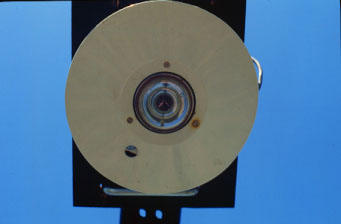Shortwave Radiation Balance
Solar radiation is radiation primarily in the wavelength range of 0.25-4 µm (99% of the total incoming solar radiation is in this range.) In practice, shortwave instruments generally measure in the range of 0.3 - 3 µm. Solar radiation flux densities vary significantly among regions due to season, time of day, surrounding terrain elevation and obstructions. Shortwave solar radiation can be separated into two components: direct and diffuse beam. Diffuse beam is the portion of the radiation that has been scattered by gas molecules and suspended particles in the atmosphere and reaches the earth's surface from multiple directions. The direct component is the portion of radiation that reaches the earth's surface in relatively parallel beams. The shortwave radiation balance can be computed by equations (1) or (2).
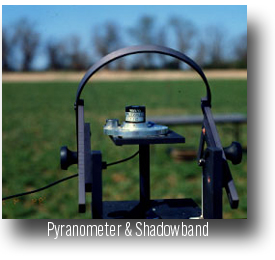
| (1) | |
| or | |
| (2) |
where Rswbal =Shortwave Radiation Balance (W m-2)
![]() = incoming shortwave radiaiton (W m-2)
= incoming shortwave radiaiton (W m-2)
![]() = reflected shortwave radiation (W m-2)
= reflected shortwave radiation (W m-2)
r = reflectivity of the surface or albedo =  ( Unitless )
( Unitless )
Instruments
The pyranometer is an instrument used to measure direct and diffuse shortwave radiation arriving from the whole hemisphere (usually a complete sky). Some pyranometers can be inverted to measure the reflected shortwave radiation from a surface. In addition, with a shading device to obstruct the direct solar beam, it can measure the diffuse radiation. Examples of widely used pyranometers are those manufactured by Eppley, of which there are two types, and a silicon cell pyranometer manufactured by LI-COR. A limited region of the shortwave spectrum, specifically photosynthetically active radiation (PAR) (0.4-0.7 µm), can be measured with a specialized pyranometer called a quantum sensor. A photo-diode quantum sensor is manufactured by LI-COR.
a) Epply Precision Spectral Pyranometer, PSP
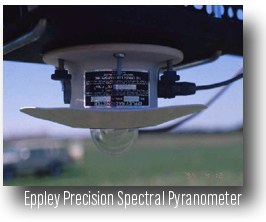 This instrument is considered to be the most accurate radiometer produced commercially for the measurement of global sun and sky radiation, totally or in defined wavelength bands. It can be inverted to measure reflected shortwave radiation (from which the albedo can be calculated).
This instrument is considered to be the most accurate radiometer produced commercially for the measurement of global sun and sky radiation, totally or in defined wavelength bands. It can be inverted to measure reflected shortwave radiation (from which the albedo can be calculated).
The PSP has a circular multi-junction thermopile of the plated (copper-constantan) wire wound type which is temperature compensated in order to get a response that is independent of ambient temperature. The temperature sensed by the detector is nearly linear with the flux density of incident radiation. The instrument is supplied with a pair of removable precision ground and polished concentric hemispheres of Schott optical glass. The inner hemisphere is transparent to a wavelength of 0.285-2.800 µm. The outer dome can be replaced by Schott glass hemispherical filters which transmit within specified bandwidths. Desiccant is placed in the side of the instrument to absorb humidity inside the glass domes. Measurements are reported in Wm-2.
b) Epply Black & White Pyranometer
This pyranometer also measures global, reflected, and diffuse shortwave radiation. The detector is a differential electroplated (copper-constantan) thermopile with the cold junction receivers whitened and the hot junction receivers blackened. The black absorbs and the white reflects radiation, developing temperature differences. The greater the temperature difference that develops between the white and black areas, the greater the flux density. Measurements are reported in Wm-2.
c) Li-Cor Silcon Chip Pyranometer ( LI - 200SA )
 Silicon photo diode technology has made possible relatively low cost pyranometers of reasonable accuracy. The LI-COR pyranometer is cosine corrected up to 80 angle of incidence. (Cell response deviates from Lambert's cosine law. This can be corrected for, in part, by the use of a plastic diffuser, anti-reflection coating or by texturing the surface (Iqbal, 1983).) The response of the photo diode sensor (Figure 1) is not ideal, covering 0.400-1.100 µm instead of a spectral response in 0.280-2.800 µm range. This does not cause serious error provided the photo diode is used only for solar radiation and not under conditions of altered spectral distribution. Thus, they should not be used to measure reflected radiation, vegetation-transmitted shortwave radiation or artificial light sources such as metal halide lamps used in greenhouses. Although the accuracy is not as high (due to spectral characteristics) as the Eppley pyranometer it is still adequate for most purposes and the LI-COR instrument's response is virtually instantaneous. Measurements are reported in Wm-2.
Silicon photo diode technology has made possible relatively low cost pyranometers of reasonable accuracy. The LI-COR pyranometer is cosine corrected up to 80 angle of incidence. (Cell response deviates from Lambert's cosine law. This can be corrected for, in part, by the use of a plastic diffuser, anti-reflection coating or by texturing the surface (Iqbal, 1983).) The response of the photo diode sensor (Figure 1) is not ideal, covering 0.400-1.100 µm instead of a spectral response in 0.280-2.800 µm range. This does not cause serious error provided the photo diode is used only for solar radiation and not under conditions of altered spectral distribution. Thus, they should not be used to measure reflected radiation, vegetation-transmitted shortwave radiation or artificial light sources such as metal halide lamps used in greenhouses. Although the accuracy is not as high (due to spectral characteristics) as the Eppley pyranometer it is still adequate for most purposes and the LI-COR instrument's response is virtually instantaneous. Measurements are reported in Wm-2.
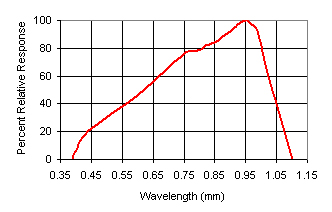
Figure 1 - LI-200SA LI-COR pyranometer spectral response curve.
d) Li-Cor Quantum Sensor ( LI - 190SA )
A silicon photo diode with an enhanced response in the visible wavelengths is used as a PAR sensor. This type of sensor was selected because it approximates the photosynthetic response of plants (Figure 2) A visible bandpass interference filter in combination with color glass filters is mounted in a cosine corrected head. Error calculations indicate that under sun-and-sky radiation, and various natural or artificial light sources, the relative errors in measurement are less than ±5%. Therefore, this sensor can be used within or inverted over canopies and in greenhouses, controlled growth chambers and confined laboratory conditions. Generally this instrument measures hemispherical incoming radiation, however, when placed within a canopy the instrument acts as a point source detector. Measurements are reported in µmol m-2 s-1.
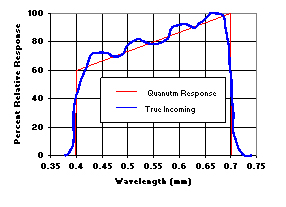
Figure 2 - LI-190SA LI-COR quantum sensor spectral response curve
e) Li-Cor Line Quantum Sensor ( LI-191SA )
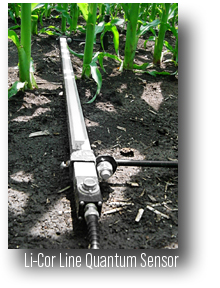 A Line Quantum Sensor measures spatially over a one meter length. The spectral response of this instrument is similar to the ordinary quantum sensor, however, the cosine correction of the line quantum sensor is not nearly as good as that of the LI-190SA (Figure 3.) Measurements, for both instruments, are reported in units of µmol m-2s-1. (Full sun plus sky photosynthetic photon flux density is approximately 2000 µmol s-1m-2.)
A Line Quantum Sensor measures spatially over a one meter length. The spectral response of this instrument is similar to the ordinary quantum sensor, however, the cosine correction of the line quantum sensor is not nearly as good as that of the LI-190SA (Figure 3.) Measurements, for both instruments, are reported in units of µmol m-2s-1. (Full sun plus sky photosynthetic photon flux density is approximately 2000 µmol s-1m-2.)
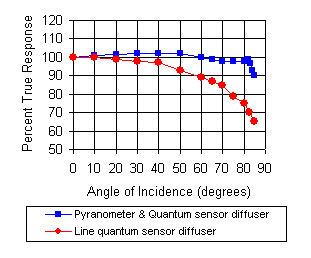
Figure 3 - Performance of instruments (LI-COR pyranometer, quantum sensor and line quantum sensors) with cosine corrections with a true cosine corrected instrument.
- Eppley Laboratory, Inc.
12 Sheffield Avenue
Newport, RI 02840
(401) 847-1020
Internet: http://www.eppleylab.com/ - LI-COR, Inc.
Box 4425
Lincoln, NE 68504
(402) 467-3576
Internet: http://www.licor.com/
Incoming Components
Incoming radiation can be separated into individual components of diffuse and direct radiation so that
(3) |
The direct component is more difficult to measure than the diffuse component and the total radiation, so the latter of the two are measured directly and the direct component is calculated. The total radiation is measured by using an instrument with an unobstructive view. The diffuse component is measured by attaching a shadowband to an instrument and correcting for the part of the sky that is obstructed for the instruments view.
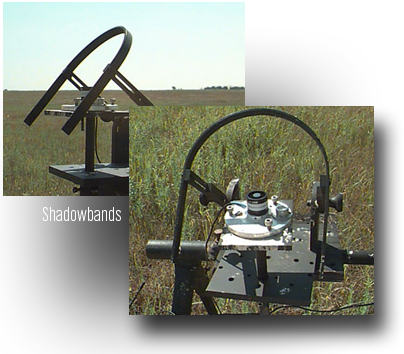
Calibration
The calibration of shortwave radiometers should be done with respect to the World Radiation Reference (WRR). In the field there are two procedures to check for constancy of instrument sensitivity. One way is to compare a calibrated pyranometer side by side with field instruments at least once a year, ideally under cloudless conditions. A linear regression can be used to determine the calibration coefficients. Another way is to repeat the basic radiometric calibration by using a pyrheliometer (an instrument for measurement of direct solar radiation flux at normal incidence) or a thermopile-type derived standard. The calibration factor is the ratio of the measurement from the test pyranometer to the measurement from the reference pyranometer. Usually, good calibrations of the precision spectral pyranometers reproduce the WRR to ± 1% and the black and white pyranometer to ± 2%.
Quantum sensors and line quantum sensors must be returned to the factory to be recalibrated.
Installation
The instrument has to be securely attached to a stand, and it has to be leveled or mounted parallel to the surface of interest. Do not subject the instrument to shocks or vibrations during installation or operation. The cable that connects the pyranometer with the data storage device should be a twin conductor and waterproof. If there is a chance of electrical interference (e.g., from power lines or radio transmissions) the cable should be shielded.
For measurement of incoming shortwave, pyranometers should be placed on a readily accessible site that is free from any significant obstruction above the plane of the sensing element. If possible, locate the instrument such that
- a) a shadow will not be cast on it at any time;
- b) it should not be close to light-colored objects that could reflect sunlight on it
- c) it should not be exposed to artificial radiation.
- d) keep domes or diffusers clean
In most field applications if a pyranometer is inverted to measure reflected shortwave radiation, it should be mounted at least 1 to 2 meters above the top of the vegetation or other surface being measured (Reifsnyder, 1967).
Click Here for Sample Data
Operation and Maintenance
There are three main requirements to ensure the collection of reliable data. They are:
- a) periodic verification of instrument calibration (at least once a year);
- b) application of corrections, if necessary, to account for instrument obstruction to a free horizon;
- c) replace desiccant (if applicable) often.
If the internal surface of the Eppley pyranometer outer hemisphere becomes coated with moisture, it can be cleaned by carefully removing it on a dry day. The inside should not be wiped unless smears are visible. The external surface of the inner hemisphere of the precision spectral pyranometer can also be cleaned when the large hemisphere is removed. If moisture has to be removed from the inside of the small hemisphere (or from the single hemispherical envelope of the black and white model), it should be done with extreme care, because the thermopile will be unprotected and it could be severely damaged.
The desiccant present in the pyranometer or net radiometer case should be inspected. If the silica gel drying agent is pinkish or white, it should be replaced. N.B. silica gel can be rejuvenated by drying in an oven at 135oC for a few hours until it turns a dark blue color.
References
Iqbal, M. 1983. An introduction to solar radiation. Academic Press, New York
Reifsnyder, William E.1967. Radiation geometry in the measurement and interpretation of radiation balance. Agr. Meteorol. 4:255-265
